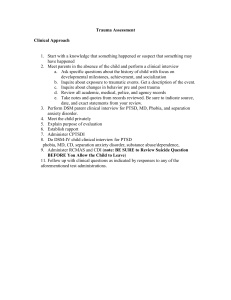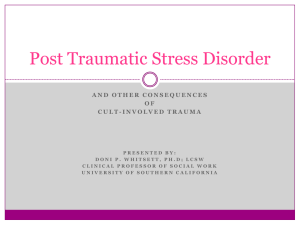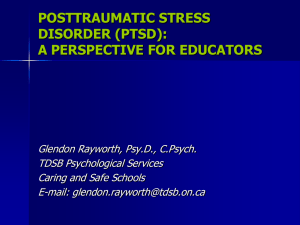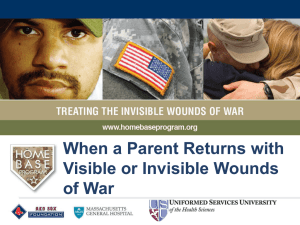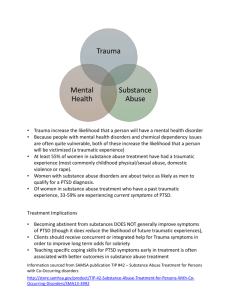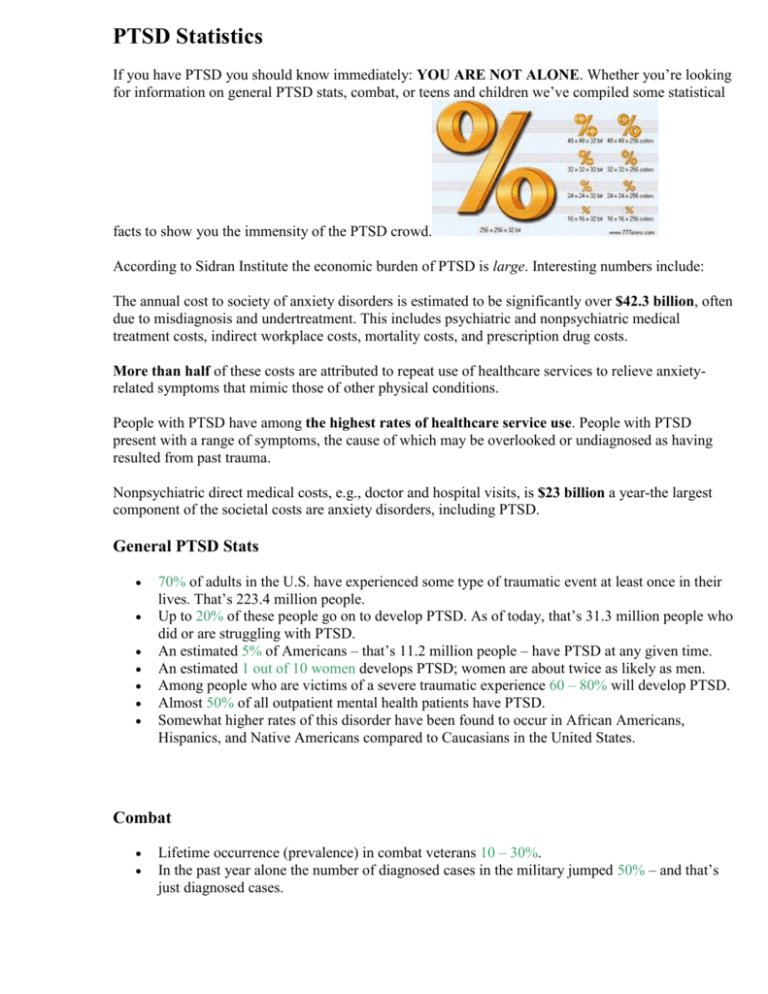
PTSD Statistics
If you have PTSD you should know immediately: YOU ARE NOT ALONE. Whether you’re looking
for information on general PTSD stats, combat, or teens and children we’ve compiled some statistical
facts to show you the immensity of the PTSD crowd.
According to Sidran Institute the economic burden of PTSD is large. Interesting numbers include:
The annual cost to society of anxiety disorders is estimated to be significantly over $42.3 billion, often
due to misdiagnosis and undertreatment. This includes psychiatric and nonpsychiatric medical
treatment costs, indirect workplace costs, mortality costs, and prescription drug costs.
More than half of these costs are attributed to repeat use of healthcare services to relieve anxietyrelated symptoms that mimic those of other physical conditions.
People with PTSD have among the highest rates of healthcare service use. People with PTSD
present with a range of symptoms, the cause of which may be overlooked or undiagnosed as having
resulted from past trauma.
Nonpsychiatric direct medical costs, e.g., doctor and hospital visits, is $23 billion a year-the largest
component of the societal costs are anxiety disorders, including PTSD.
General PTSD Stats
70% of adults in the U.S. have experienced some type of traumatic event at least once in their
lives. That’s 223.4 million people.
Up to 20% of these people go on to develop PTSD. As of today, that’s 31.3 million people who
did or are struggling with PTSD.
An estimated 5% of Americans – that’s 11.2 million people – have PTSD at any given time.
An estimated 1 out of 10 women develops PTSD; women are about twice as likely as men.
Among people who are victims of a severe traumatic experience 60 – 80% will develop PTSD.
Almost 50% of all outpatient mental health patients have PTSD.
Somewhat higher rates of this disorder have been found to occur in African Americans,
Hispanics, and Native Americans compared to Caucasians in the United States.
Combat
Lifetime occurrence (prevalence) in combat veterans 10 – 30%.
In the past year alone the number of diagnosed cases in the military jumped 50% – and that’s
just diagnosed cases.
Studies estimate that 1 in every 5 military personnel returning from Iraq and Afghanistan has
PTSD.
20% of the soldiers who’ve been deployed in the past 6 years have PTSD. That’s over 300,000.
17% of combat troops are women; 71% of female military personnel develop PTSD due to
sexual assault within the ranks.
Doing the breakdown by war:
Afghanistan = 6 – 11% returning vets have PTSD
Iraq = 12 – 20% returning vets have PTSD
Teens and Children
15-43% of girls and 14-43% of boys will experience a traumatic event
3-15% girls and 1-6% of boys will develop PTSD
As many as 30 – 60% of children who have survived specific disasters have PTSD
According to the National Center for PTSD: “Rates of PTSD are much higher in children and
adolescents recruited from at-risk samples. The rates of PTSD in these at-risk children and
adolescents vary from 3 to 100%.”
3 - 6% of high school students in the U.S. who survive specific disaster develop PTSD
More than 33% of youths exposed to community violence with experience PTSD
According the the National Center for PTSD: “Studies have shown that as many as 100% of
children who witness a parental homicide or sexual assault develop PTSD. Similarly, 90% of
sexually abused children, 77% of children exposed to a school shooting, and 35% of urban
youth exposed to community violence develop PTSD.”
(Photo: Ahasoft)
Read More
o ‘Your Life After Trauma’ Weekly Radio Show
‘Your Life After Trauma’: Our Next Guests
‘Your Life After Trauma’ Archives
Your Life After Trauma: Be Our Guest!
Sponsor ‘Your Life After Trauma’
o What is PTSD?
o How Survivors Define PTSD
o PTSD Symptoms
o Popular PTSD Questions
o PTSD Causes
o PTSD Test
o PTSD Statistics
o PTSD & The Brain
o PTSD Videos
o PTSD Caregivers Support
o Support for PTSD Professionals


